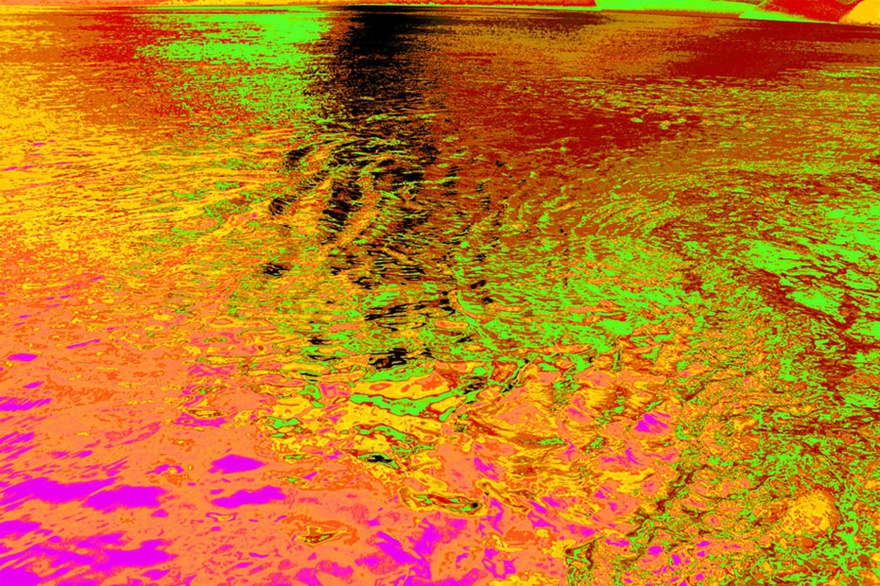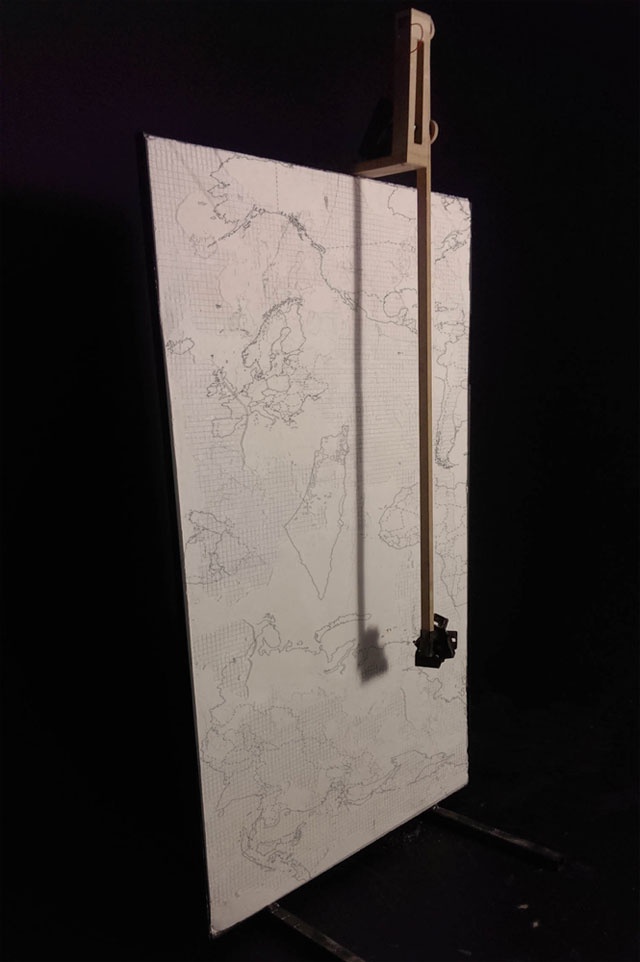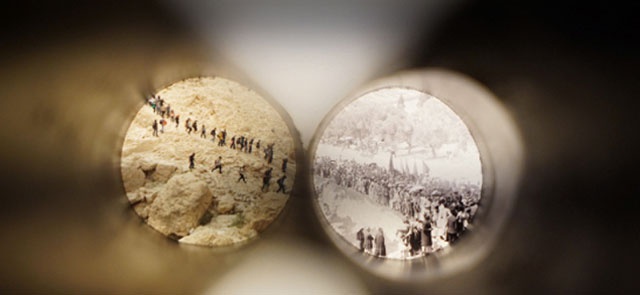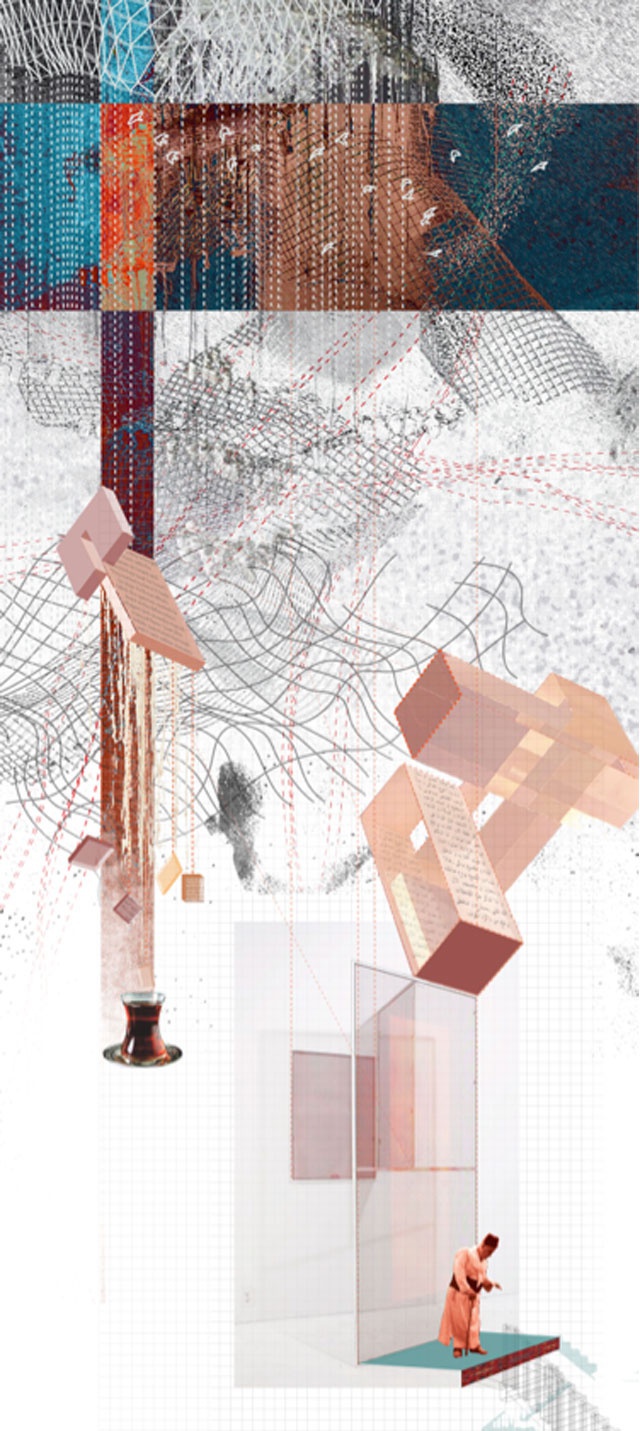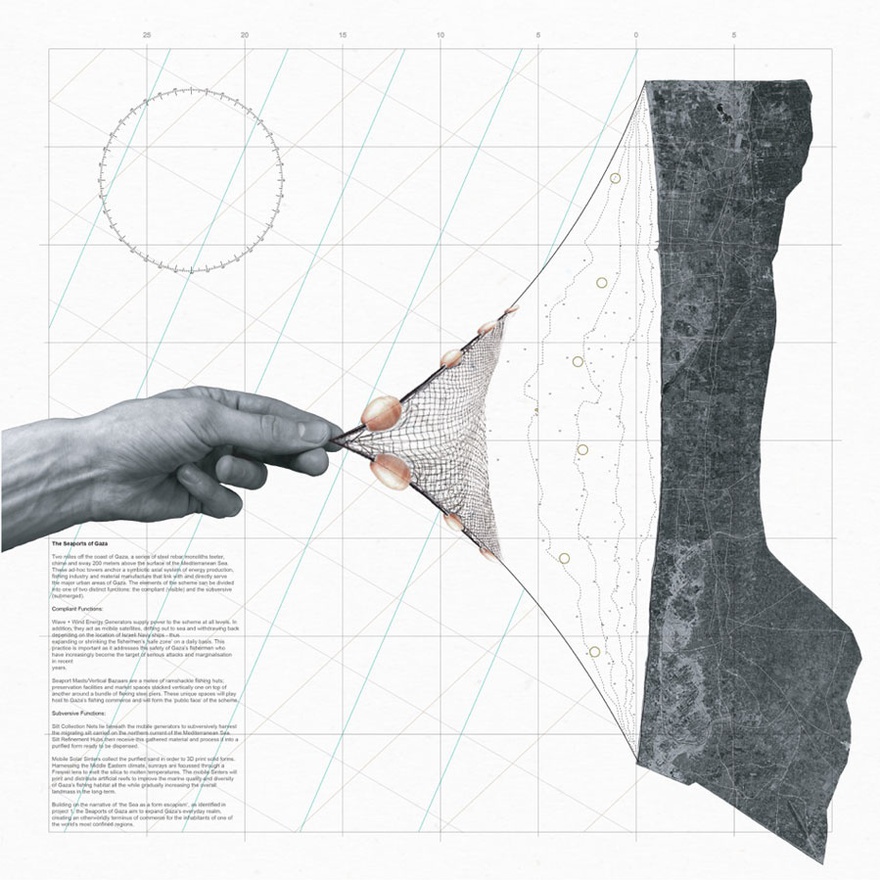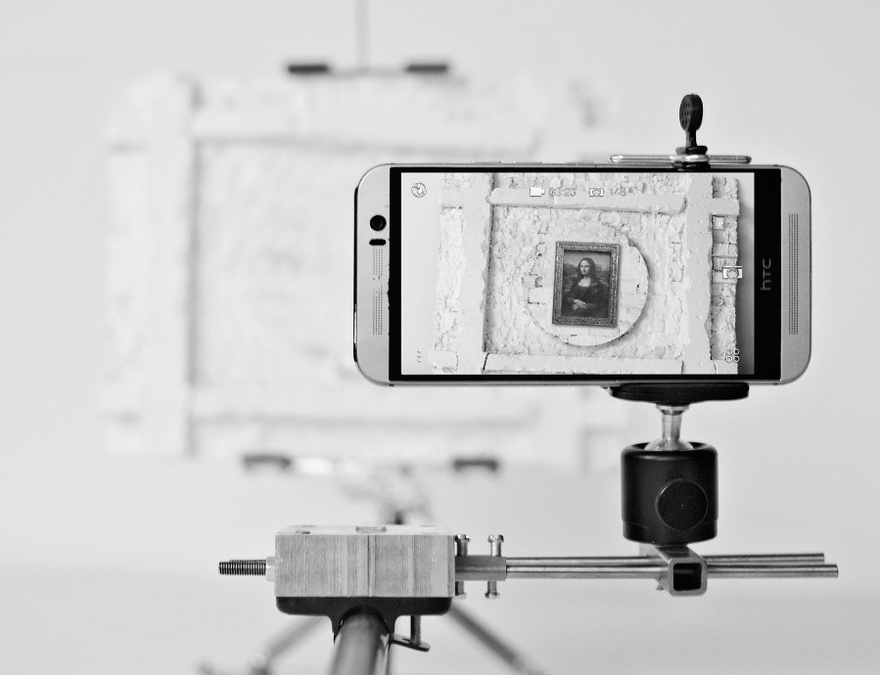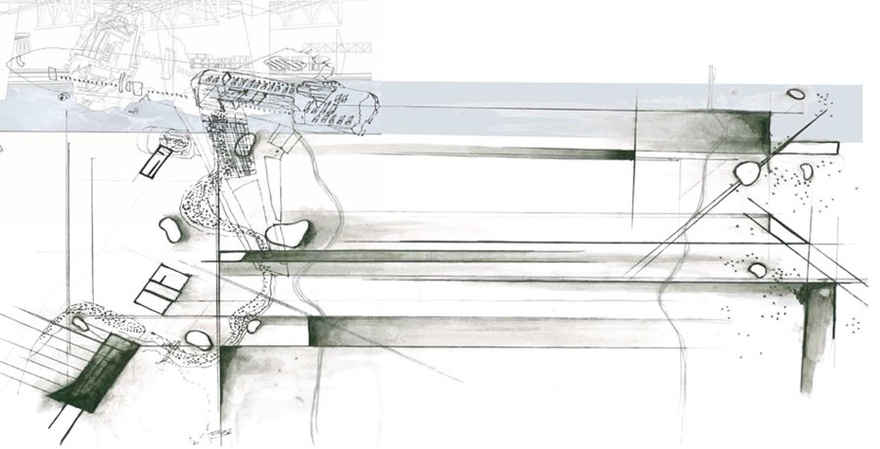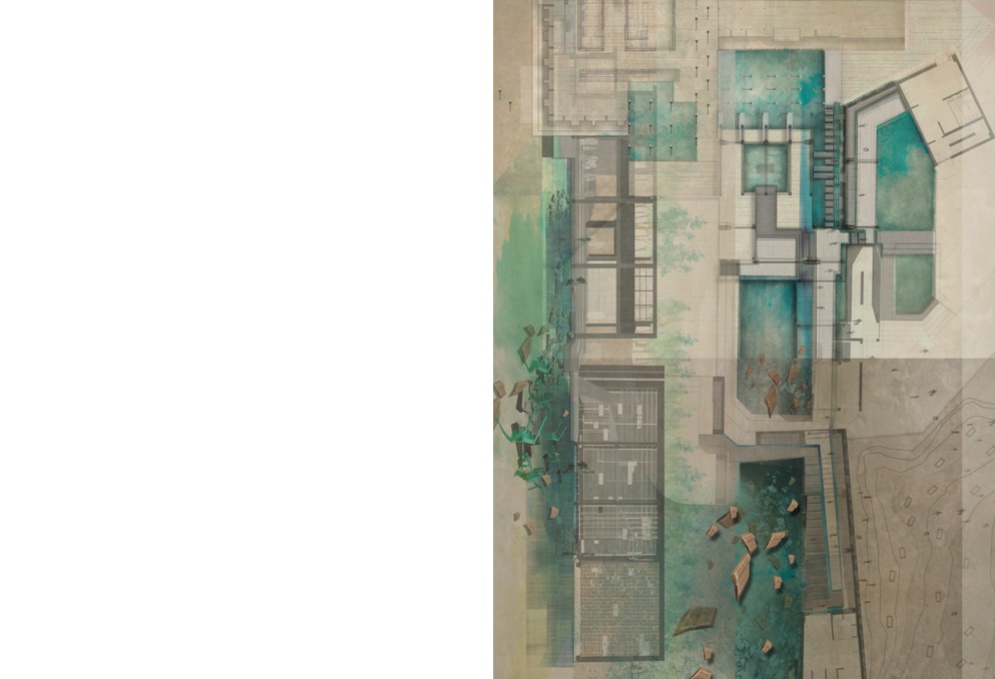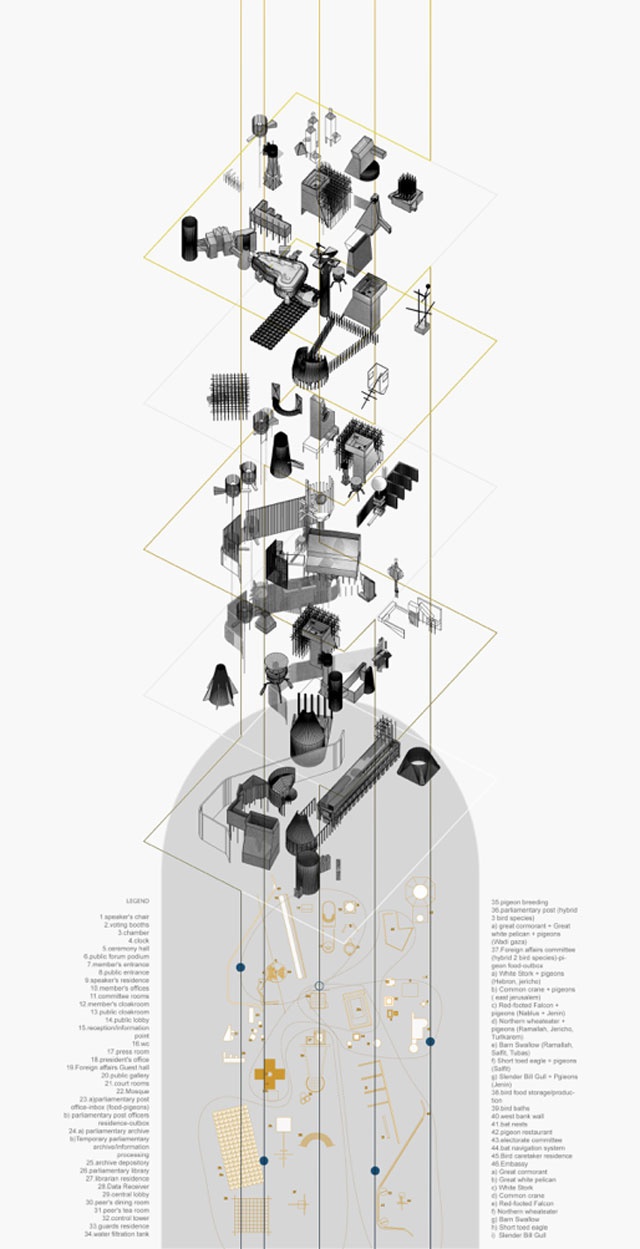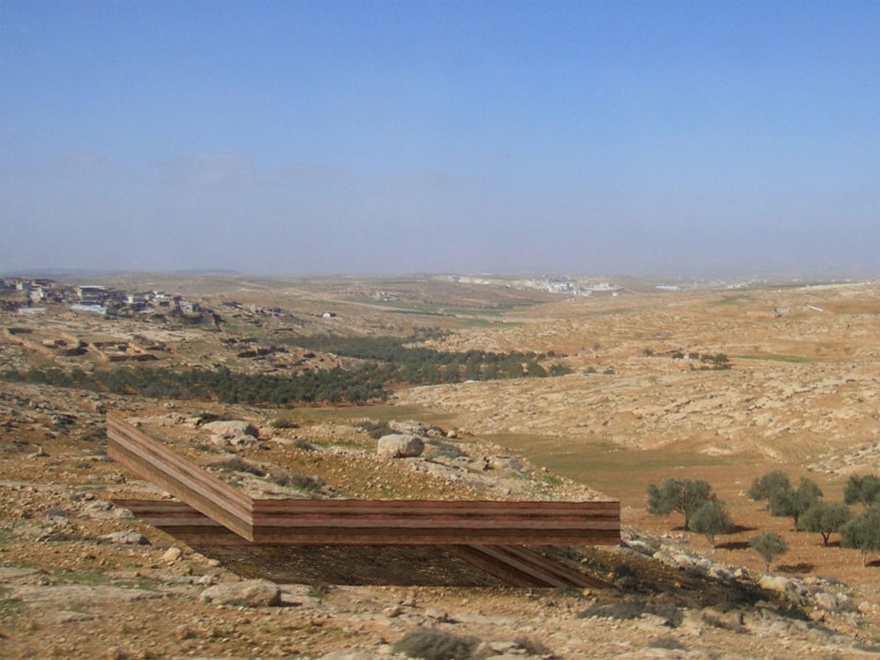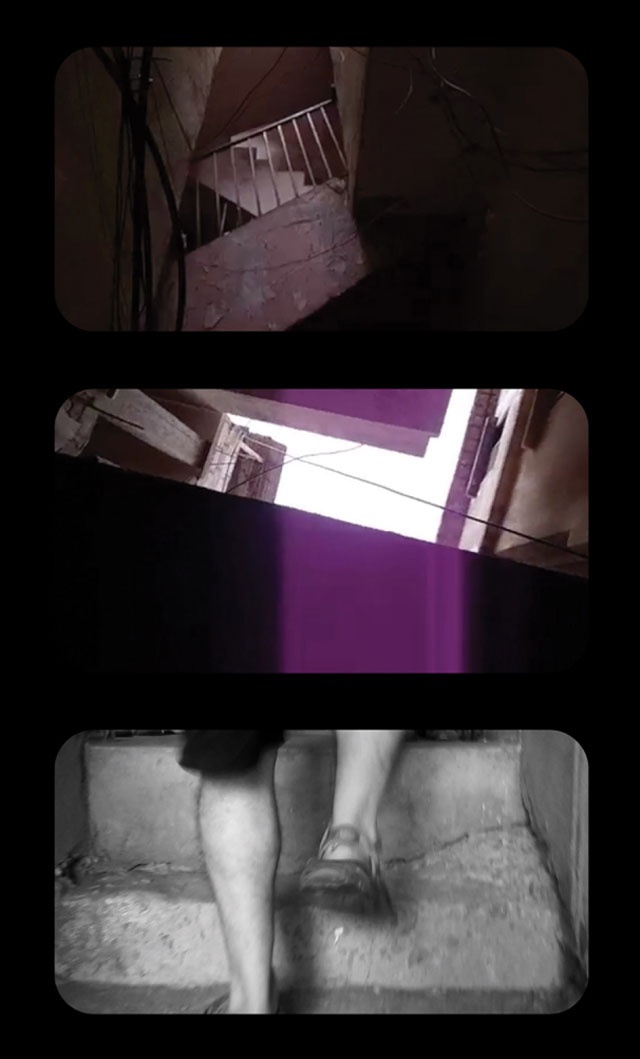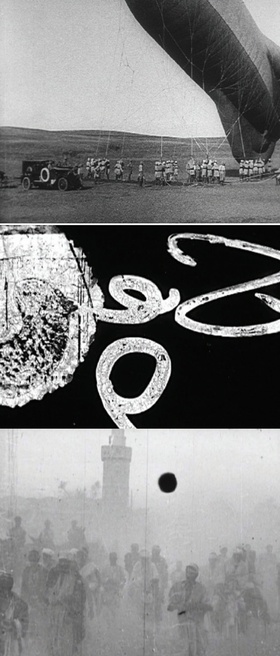Publications
Qalandiya International 2016
Moments for Possibilities 'Air, Land and Sea': London
Moments for Possibilities: Air, Land and Sea
Location: London, England
Venue for exhibitions & installations: MG14 Room, University of Westminster, 35 Marylebone Road, NW1 5LS.
Venue for screenings: P21 Gallery, 21 Chalton Street, NW1 1JD.
Venue for screenings & talks, and the London Encounters Symposium: The Mosaic Rooms, Tower House, 226 Cromwell Road, SW5 0SW (venue for the Encounters Symposium), and P21 Gallery, 21 Chalton Street, London NW1 1JD.
Dates: Runs through 31 October, 2016.
Organizers: Palestine Regeneration Team (PART)
Curators: Nasser Golzari and Yara Sharif
Artists: Click on the names below to visit each artist's section
Palestine Regeneration Team (PART): Nasser Golzari, Yara Sharif, Murray Fraser. In addition to Michael Sorkin, Peter Kosminsky, Judy Price, Laila Shawa, Naoko Takahashi, Fatemah Araghi & Sama Khan, Sarah Beddington, Rim Kalsoum, Angeliki Sakellariou, Mathew Beaumont, Andreas Christodolu, Claudia Turton, Claire Humphreys, Phoebe Burnett, Victoria Thong Jiahui, Dean Robson VanderVord, Nassos Hadjipapas, Santiago Rizo Zambrano, Samar Maqusi, Shahmeer Khan & Adhitya Pandu.
Click on the links below to visit each section
Curatorial statement by Nasser Golzari and Yara Sharif
Screenings and Talks programme
Click here to download the full PDF programme for Moments for Possibilities: Air, Land and Sea
Nasser Golzari and Yara Sharif
With land distribution and urban morphology in Palestine now being pushed to their extremes through the inclusion of certain communities, and the exclusion of others, the aim of this London event is to explore alternative means of re-reading 'Air', 'Land' and 'Sea' within the region by stripping away the dominating power of lines on the ground. Stemming from the need for an alternative discourse that can heal and nourish real physical space as well as the space of imagination, it looks at 'Air, Land and Sea' in the hope of redefining a new geography beyond the currently enforced borders.
Through acts of 'cutting' and 'breathing', the event will include works that demonstrate the possibilities of reconstructing and stitching together fragmented spaces and Palestinian diasporic communities. 'Air, Land and Sea' will be the medium where boundaries are blurred and surfaces are merged. It aims to engage with nature and allow the cultural landscape to heal itself again in a constant process of wrapping and stitching together.
This London event will consist of exhibitions, digital fabrications, talks and film screenings as mediums to explore everyday lives and new kinds of space in Palestine, the Mediterranean sea, and beyond-both virtually and physically. Moments for Possibilities: Air, Land and Sea suggests a world where the invisible can be rendered again as visible, and where the subject of return is achievable. It questions the idea of 'moments of home', located on the thresholds of waiting, whether for those who have been displaced once or who are in a condition of constant displacement.
Palestine Regeneration Team (PART): Nasser Golzari, Yara Sharif, Murray Fraser.
'LAND'/'AIR'
The Digital Garden – Whispering Soil
This an interactive installation inspired by ordinary objects used by Palestinians to hold on to their right to the land and prevent their stories from being lost by continuous' looting' of their history/memories. It suggests a subversive medium to narrate and preserve building on the contemporary obsession with digital media today, whereby the number of text messages received and sent daily exceeds the population of the world.
The Digital Garden utilises the 'digital cloud' as an additional means to reclaim the right of the land and narrate the stories of the Palestinian diaspora. The device is made of three individual pieces when put together they form the Whispering Soil. While one piece contains a physical soil sample from the land, the second will contain hair and nail sample of individual citizens as DNA proof. The third piece contains the narrative in a digital format saved onto a USB device.
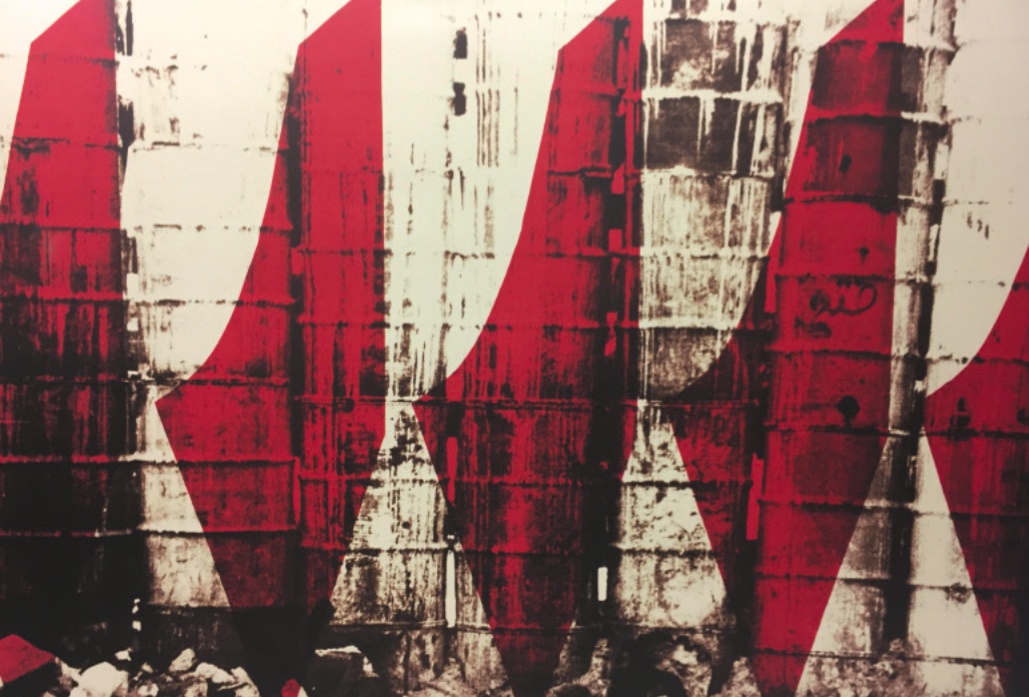
'LAND'
The Walls of Gaza
I believe that one of the roles of contemporary artists is to record the signs of their times and to communicate that reality to their audiences. During a period of four years, and since the beginning of the First Intafada, the Palestinian uprising, I have been searching for the method/medium with which to record the raw dialogue appearing on the walls of Gaza, between the Palestinian different factions, and between Palestinians and their Israeli occupiers.
The dialogue on the walls of Gaza is a method of communication resorted to by Palestinians. Very different from the graffiti known in the west, and in the absence of any mode of communication, completely banned by the Israelis, such as newspapers or television, it has become the only method of self-expression and communication left to them during a ruthless and destructive occupation indifferently observed and ignored by 'the civilized world', and still in place.
Variation of C
A spoken-word performance produced for the Qalandiya International 2016, London, creating soundscape with layers of voices, reflecting, live-streaming, to explore the biennale's theme, Moments for Possibilities: Air, Land and Sea. It will be shown at the exhibition opening.
Waiting
It has been a century worth of waiting for Palestine and a lifetime of waiting for the Palestinians. The refugees wait for the right to return home. Gazans wait for the electricity. Commuters wait on checkpoints. Fishermen wait for right to the sea. Daily life is all about waiting, wait for clean water, food supplies, and all the other basic necessities that humans require on a daily basis. A perpetual state of waiting… If the conditions persist in 4 years time, Gaza will no longer be inhabitable.
The aim of this installation is to raise awareness of the criticality of the situation. The 'machine' is a metaphor for waiting and a representation of the context. As the pendulum hits the wall, it wears off the surface bit by bit. The question is how long could this last?
Migration Cloud
Inspired by the (un)told stories of the journeys of Syrian refugees, the work with its series of illustrations, seek to project the voices of the Syrians and people who have a close connection with the country to share the stories they have.
Syrians have many traditions, two of which are the traditions of storytelling and preserving. Storytelling is seen to be the most powerful means of communicating a message. The storyteller, or Hakawati, traditionally was a central figure in Syrian society. Throughout its 300-year existence, the Al Nofara café in Damascus' stone-built Old City has always had a Hakawati telling stories in evening gatherings. The last remaining Hakawati of Damascus is a 65-year-old man and people are worried that the tradition of storytelling will die with him. This project seeks to preserve the tradition of storytelling, which many Syrians hold dear to them.
Reclaiming the sea
The areas surrounding the Mediterranean Sea have been a place of complex systems of ideas, ancient cultures and religions. Today, these waters represent hope, exodus and a passage to the unexpected.
The continuous interaction between sea and earth can lead to an aggressive dialogue and a constant act of claiming space from each other, resulting in the formation of uncertain and shifting boundaries.
Not far from the current situation in Palestine, the unchoreographed movement of the sea is non-static and unpredictable and it can be interpreted as a change of equilibrium, an imbalance and in some cases a violent invasion. It is characterised by an improvisation and instability of an indefinite duration.
Observing and representing the movement of the sea is part of the process of understanding it. The role of boundaries becomes vital during this journey. Where does the sea stop moving?
The Seaports of Gaza
'SEA'
Two kilometres off the coast of Gaza, a series of steel rebar monoliths teeter, chime and sway above the surface of the Mediterranean Sea. These ad-hoc towers anchor a symbiotic axial system of energy production, fishing industry and 'land extension' that link with and directly serve the major urban areas of Gaza. The elements of the scheme, that reclaims the sea, can be divided into one of two distinct functions: the compliant (visible) and the subversive (submerged). Compliant functions include: Sea Lanterns, Vertical fishing Village, silt collection nets, silt refinement hubs & solar sinters.
#Gazagram: The Finite City
‘Land, AIR’
Gazagram is a fictional app which uses triggers within the fabric of the new community centres to project curated augmented reality exhibitions. Taking inspiration from Gazans passion for smartphones, social media and the internet which allow them to connect with and learn from a world they cannot physically access.
Finite City takes the form of community incubators with the purpose of supporting residents who return to rebuild their homes by providing waste disposal, electricity and clean water. The project's overriding aim is to invert pockets of destruction within the fabric of the city into moments of opportunity. Retrospectively inserting vital public space into an overcrowded, unplanned city, whose citizens cannot leave.
Take Off
'AIR'
'Take Off' is a zero-gravity zone located on the sea of Gaza to allow the Gazans to 'fly' despite the entrapment enforced on them by destroying their airport and seaport.
The imagined possibilities between 'Land Sea and Air' suggest moments of irony where Gazans can travel through wind tunnels in a spaceship-like experience to a new horizon beyond earth. A space that responds to their aspirations to fly, float and dream and yet, mark their right of movement.
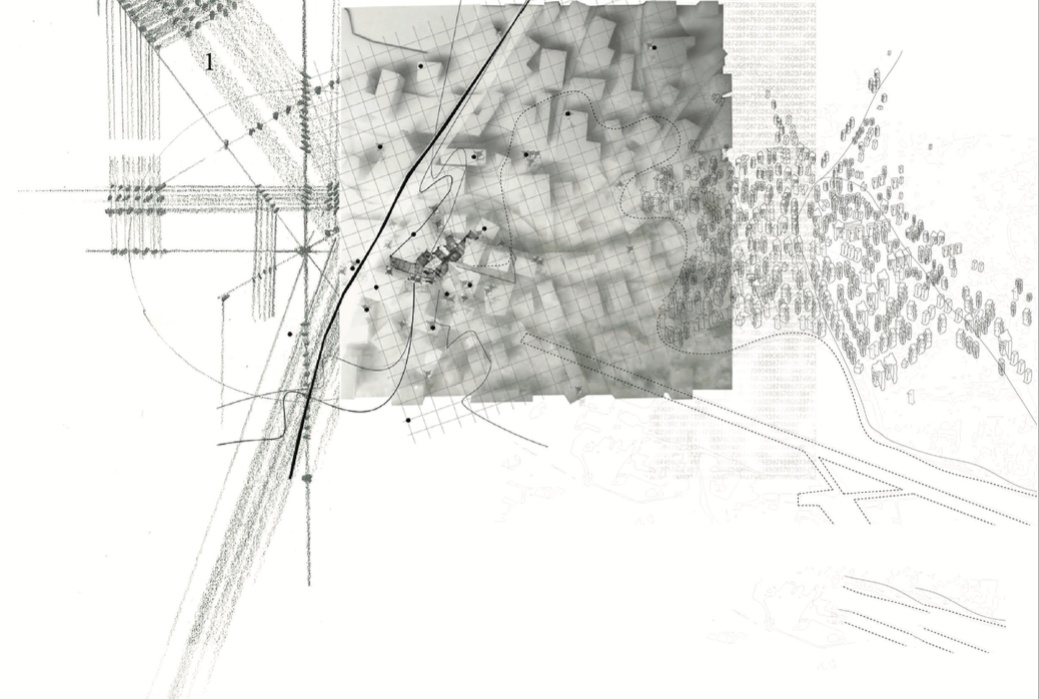
Lost Home/ Area X
'LAND'
'An absentee? How can I be an absentee when I am standing right in front of your honour?' (Amiry, 2016)
Area X is a new unconstrained municipality that lies in Kufur Aqab, a neighbourhood that sits within the municipal boundaries of Jerusalem, suspended between Ramallah and East Jerusalem there lies an animated house which tackles the issues of the absentee law. Vulnerable to fall under full Israeli jurisdiction since the law has been implemented, the theatrical approach of absence and presence within Area X marks an illusion to Israeli control by disrupting the system of the loss of identity and home.
Fragments of Home
'LAND'
Fragments of Home is an exploration of the notion of home and domesticity in the context of the ongoing Israel occupation, focusing on Jerusalem with modern day displacement. This project fixates around this threat that the Israeli's enforce on the Palestinians', developing a temporary sanctuary for the modern day displaced. The new 'architectural typology' will inhabit the blurred borders of Qalandia refugee camp. The site is constraint to 6 metres wide border encasing the camp, forcing the architecture to develop vertically, rather than sprawling across the land. The architecture is created through distilling and examining the theory of home. Emphasizing and exaggerating components so as to make the sub-conscious – conscious, the non-tangible – tangible.
Mamilla National Park
A Landscape of 'Lost Property
As a response to the controversial Museum of Tolerance built by the American-Jewish Simon Wiesenthal Center (SWC) on the ancient Mamilla Cemetery, the project proposes a series of archives, libraries and museums to recreate a 'landscape of lost property' dedicated to generations of Palestinians in the West Bank and diaspora abroad, symbolically returned to the heart of Jerusalem; where they cannot be.
Designed as a flooded landscape, the project gains greater poetic meaning as a reflection on the incredibly vulnerable socio-political fate of the Palestinian state. Water; fluid/ neutral is the antithesis of territory/ terra firma, a concept which has lost all physical and symbolic meaning in the Palestinian situation. The theme of vulnerability permeates the scheme and becomes the overarching design intent in the cemetery where even in death, one can never return to a permanent resting place or home.
'LAND'
Agrarian Arcadia: The lot Palestinian Utopia
This thesis is a polemic against the shifting 'buffer' and 'no-go' zones, which in 2014, covered over 40% of the Gaza Strip. To subvert the siege, focus is on empowerment via self-sustainability; with attention on the security of food and water resources. By reclaiming the agricultural lands that are within these high risk zones, short term reliance on the border is eased while an epic strategy is prepared.
The project's ambition is to implement a new collective socialist structure that contrasts current fascist oppression. Parallels with other societies are drawn to support the project, such as: the Soviet Union's collectivisation of its 'Kolkhoz' farms, and Israeli utopian 'Kibbutz'.
Altering the landscape also brings into question the role of the Palestinian landscape as a symbol of national identity. A subject at the core of historical and current socio-political tension. The mechanical fields become a palimpsest for the polemic, reflecting the tenacity of Palestinian people.
The Virtual Agora
‘AIR’
Addressing the problems of community detachment in Palestine along with both its physical and notional obstacles, to popular representation, The Virtual Agora aims to re-calibrate the issues of the people as a unity in conjunction with the disputes pertaining to its physical territory.
The Athenian Agora is used as a thinking model to investigate a new architectural proposition, where territories are plotted strategically through the trajectories of 1948 Palestine. The map of the agora is drawn by – overlaying Air, Land and Sea – extrapolating and superimposing historical and geological data. By plotting the routes of migratory birds the maps create an ever expanding time-based digital archive that will be transferred and safeguarded to challenge the vanishing landscape; simultaneously a physical archive will reclaim its archaeological significance to the Palestinian civilisation.
Democratisation of the Land
‘LAND’
In an imagined scenario to rethink the return of the refugees and the reclamation of land, the work takes the absurd realities of today to the extreme. Playing the role of the architect and the cynical role of the real-estate developer the land is sliced to equal parts. The work is a provocation to the current conditions of division and fragmentation suggesting practical yet impossible scenarios.
Narrative of a Space
After 67 years of refuge, the other Palestinian space, the Palestinian refugee camp, as space and people, represents a crucial element of analysis and investigation within the larger Palestinian narrative, especially that it constitutes an accumulation of years of continued oppression, destruction, and re‐construction. Yet, Palestinian camps have overwhelmingly been presented as either passive sites of international aid, or conflictual sites of Palestinian political scrutiny. This has lead to continuous manipulation and misrepresentation of the Palestinian camp, and a stripping away of the fascinating narratives of resistance, resilience, struggles and adaptability that the refugees has built over decades of refuge. It is those intimate narratives, on intimate scales of the larger camp which need to become visible. The work unpacks these layers in the aim to develop a new kind and scale of dialogue.
Whispering Soil
Whispering Soil (device), is an installation for a 'digital Garden' that utilises the 'digital cloud' as a new mean to reclaim the right of the land and narrate the story of the Palestinian diaspora.
The device is made of 3 individual pieces when put together they form the Whispering Soil. While one piece contains a physical soil sample from the land, the other will contain hair & nail sample of the individual as a DNA proof. The third piece contains the narrative in a digital format saved on a USB device. The intention is to highlight the safekeeping of the precious soil but also at the same time emphasize individual narratives and new forms of representation beyond the conventional symbols. The completed Whispering Soil will then be placed in a digital garden where others can come, explore and discover the different narratives and stories.
Screenings and Talks programme
12th October 2016
19:00–20:30 // London
Film Screening and Talk: Assemblage and Reel (dr. Judy Price) & The Logic of the Birds (dir. Sarah Beddington)
P21 Gallery, 21 Chalton Street, NW1 1JD (Free Entry)
In Reel the disrupted residues of film have been selected – the lead-ins and endings of film with music composed by Johann Johannsson. The music brings to the images an intensity and spiritual dimension evoking the sensual and sublime.
The Logic of the Birds was inspired by early-20th century photographs of an old Palestinian procession showing people moving freely across the land from Jerusalem to a shrine near Jericho. Wanting to work collaboratively to consider the use of open, public space, led me to devise this project as a public processional performance in the landscape. The title of the performance/film is from a 12th-century Sufi poem. Working with young actors from Ramallah, the performance/film was staged close to the Jordan Valley, on a major trajectory for bird migration as well as a route inscribed by journeys of pilgrimage, exile and return.
Saturday 15 October & 22 October
16:00–19:00 // London
Film Screening: The Promise (dir. Peter Kosminsky)
Venue: P21 Gallery, 21 Chalton Street, NW1 1JD
Just as 18-year-old Londoner Erin sets off to spend summer in Israel with her best friend, Eliza, she unearths an old diary belonging to her seriously ill grandfather, Len. Intrigued by the life of this man she barely knows, she takes the diary with her, and is stunned to learn of his part during the British Mandate period in the post-WWII British peace-keeping force in Palestine.
As Len's story comes to life from the pages of the diary, Erin discovers the disturbing truths about his time in Palestine and the atrocities he witnessed in the 1940s.
Retracing Len's steps in modern-day occupation, Erin sets out on a heart-breaking journey in an effort to fulfill a promise made by her grandfather over 60 years ago.
Organized by: Palestine Regeneration Team (PART) in collaboration with P21 Gallery
26th October 2016
19:00–20:30 // London
Film Screening and Talk: White Oil (dr. Judy Price) & The Logic of the Birds (dir. Sarah Beddington)
P21 Gallery, 21 Chalton Street, NW1 1JD (Free Entry)
White Oil is a single screen film that excavates a number of narratives around the quarries in the Occupied Palestinian Territories of the West Bank.
There are over 350 quarries in the Occupied Palestinian Territories of the West Bank. The stone excavated has been termed the 'white oil' of Palestine and is the only raw material available to support the Palestinian economy and provides a livelihood for over 20,000 workers. However, of the stone and sand excavated from the quarries 65% is expropriated by Israel for the construction of Israel, and to build the illegal settlements in the West Bank, with Israel also exporting the stone internationally and claiming it as their own product.
White Oil explores the way the quarries are not just industrial spaces in which labour and excavation of raw material take place, but lived spaces by unfolding narratives around the day-to-day lives of the quarry owners, workers and security guards.
The Logic of the Birds was inspired by early-20th century photographs of an old Palestinian procession showing people moving freely across the land from Jerusalem to a shrine near Jericho. Wanting to work collaboratively to consider the use of open, public space, led me to devise this project as a public processional performance in the landscape. The title of the performance/film is from a 12th-century Sufi poem. Working with young actors from Ramallah, the performance/film was staged close to the Jordan Valley, on a major trajectory for bird migration as well as a route inscribed by journeys of pilgrimage, exile and return.
Saturday, 29 October
14:00–17:00 // Qalandiya Encounters London
Venue: The Mosaic Rooms, A.M. Qattan Foundation, 226 Cromwell Road, SW5 0SW
Panel: 'This Sea is Mine'
This one-day symposium will bring together adiverse group of architects, artists, filmmakersand professionals to discuss the theme of the 'This Sea is Mine'. The event includes a series of short presentations by the artists and creators of Qalandiya International London, who will share their work and ideas about 'Moments of Possibilities: Air, Land and Sea'. The symposium will question the role of artists and professionals within the complex political and economic structures that exist in Palestine, exploring whether alternatives can be offered, especially a new geography emerging from the sea, which might help to mend the fractures. Notions of 'home', waiting, 'return', absent narratives, nation states and other subjects raised by the exhibits will also be explored.
Welcome note: Nasser Golzari, Yara Sharif and Manuel Hassassian
Chairpersons: Nasser Golzari and Yara Sharif
Presenters: Pecha Kucha presentations by Bisan Abu Eisheh, Matthew Beaumont, Sarah Beddington, Andreas Christodoulou, Nassos Hadjipapas, Judy Price, Naoko Takahashi, Claire Humphreys.
Roundtable Discussion Panel: with Salem Al-Qudwa, Yazid Anani, At Home in London and Gaza, Anthony Downey, Matt Gaskin, Nasser Golzari, Harriet Harris, Manuel Hassassian, Robert Mull, Yara Sharif, Michael Sorkin, Yahya Zaloom (Yazid Anani and Michael Sorkin will be participating via video link from Ramallah and New York)
Organized by: Palestine Regeneration Team (PART) in collaboration with The Mosaic Rooms
Fatemah Araghi obtained her BA in Architecture from the University of Westminster in 2015 whilst being engaged in cultural and socio-political student-related activities alongside her studies. She was an executive assistant in Mercy Trust events and is currently the academic secretary for the Iranian Students Association of Britain. She has just completed her MA in Architecture from the University of Westminster in the history and theory research lab having fulfilled her keen interests in the field and enhanced her understandings of the theoretical perspectives that architecture entails.
Matthew Beaumont came to the University of Westminster after spending two years working in practice, firstly in a small award-winning practice in Derbyshire's Peak District and then for 14 months at Foster and Partners. Prior to this, he graduated from the University of Nottingham. For Matt, a thorough and focused analysis of social, environmental and cultural qualities of a site is key before they can be synthesised into a sensitive and strategically intelligent response. His design process is heavily centred around hand-sketching and physical model making as a means of design exploration.
Sarah Beddington is a British artist and filmmaker, currently based in London, whose work in film and video, and other ephemeral or fragile media, investigates the intersection between the social, the personal and the political, usually in relation to journeys and migration and with particular emphasis on a sense of place, time and landscape. She is currently working on a feature-length documentary film that uses the aerial perspective of birds migrating through the eastern Mediterranean to reflect on ideas around exile, return and home.
Phoebe Burnett is a postgraduate architecture student. Working closely with Nasser Golzari and Yara Sharif, her recent work and research has focused on the subject of Absentee Law, Jerusalem and Qalandiya Refugee Camp. Her work puts special emphasis on casting and making through visualizing narratives of the everyday life of refugees, and specifically in Palestine. Phoebe is currently practicing at Rock Townsend architects.
Andreas Christodoulou is an architect and designer who specializes in digital art and fabrication. His work focuses on visualizing social concepts through the built environment as a means of creating an architectural vocabulary. His most prominent projects are community based and focus on the refugee crisis in both Gaza and Lampedusa. He is currently practicing as an architectural assistant at Piercy & Company, in north London.
Nassos Hadjipapas is an architect from Cyprus, currently practicing in London. He is a tutor assistant to Nasser Golzari and Yara Sharif in the University of Westminster's postgraduate design studio, DS22. He obtained his masters in Applied Design for Architecture at Oxford Brookes University in 2015 where he developed his thesis 'Virtual Agora'. Nassos's thesis was granted 'The Fielding Dodd' prize for outstanding work and has been nominated for an RIBA Silver Medal. He is a co-founder of the 'Arteries Foundation'.
Claire Humphreys is a graduate in architecture, currently working at Rock Townsend Architects, London. She has been working on a variety of fast-paced projects, including designing bespoke furniture for Lacoste showrooms in Paris and London, University of Westminster's Harrow Library, and an installation for a Speedo product launch in the summer of 2015. Combining art and architectural practice, Claire is interested in pursuing conceptual and creative design methodologies based on social mapping animation and making. Her recent work focuses on the subject of Absentee Law and the area of Kufur Aqab, Jerusalem.
Rim Kalsoum graduated in architecture from the University of Westminster, and is currently working at Golzari-NG Architects and with the Palestine Regeneration Team (PART) in London. Rim is also a volunteer at the RIBA education and outreach programme. Her main interest in architectural design focuses on the topic of 'urbicide' and symbolic architecture, which she is currently exploring as part of the Open Gaza research project. Rim's recent pavilion design won joint first place at FABFEST, London, 2016, as part of the London Festival of Architecture.
Sama Khan is a Pakistani architect living in London. She graduated with a BA in Architecture from the National College of Arts, Lahore, Pakistan in 2013. After working in Lahore for two years, she was awarded the Dukes of Grafton Founders Scholarship for her MA in Architecture, Cultural Identity and Globalization at the University of Westminster, which she completed in September 2016. As an architect, her concern lies in issues of gender and space and the cultural constructions that exclude women from participating in public spaces.
Shahmeer Khan was born in France and raised in Germany and is currently working on several key projects within a London-based architectural office. He completed his BSc in Architectural Engineering in 2012 from the University of Westminster and after gaining work experience in the architectural and construction industry he went on to study in Oxford. He graduated in 2015 from the Oxford School of Architecture, where he received his RIBA Part 2 and M.Arch.
Samar Masqui is an urban specialist with over 9 years of experience in international development, including urban planning and development in conflict areas. In 2009 Samar began work with UNRWA as an architect/planner, where she was involved in supporting the 58 official Palestinian camps in Jordan, Syria, Lebanon, the West Bank and Gaza. Samar is also involved in documentary filmmaking and photography, and has exhibited her photography in the US. She has built spatial installations in refugee camps in Jordan and Lebanon. She is currently completing her PhD at the Bartlett School Of Architecture, University College London.
Peter Kosminsky is an award-winning British writer, director and producer. He has directed films such as White Oleander and television films like Warriors, The Government Inspector, The Promise and Wolf Hall. His films have won number of awards including those from the British Academy of Film and Television Arts (Bafta Awards).
Samar Masqui is an urban specialist with over 9 years of experience in international development, including urban planning and development in conflict areas. In 2009 Samar began work with UNRWA as an architect/planner, where she was involved in supporting the 58 official Palestinian camps in Jordan, Syria, Lebanon, the West Bank and Gaza. Samar is also involved in documentary filmmaking and photography, and has exhibited her photography in the US. She has built spatial installations in refugee camps in Jordan and Lebanon. She is currently completing her PhD at the Bartlett School Of Architecture, University College London.
Adhitya Pandu is from Indonesia and completed his bachelor degree at the University of Indonesia. Soon after, he collaborated with his tutors and became a research assistant until early 2013. He continued his studies at The Oxford School of Architecture to obtain his M. Arch (RIBA Part 2) and graduated in 2015. He currently lives and works in London.
Anna Popielarska is a recent M.Arch graduate from the University of Westminster. She completed her BA in Architecture at Oxford Brookes University, followed by two years in the industry, at Kengo Kuma Associates in Tokyo and Knight Architects, working on award-winning projects in both practices. Aside from her studies, she is a also member of the England team of the European Assembly of Architecture Students, where she has participated in architectural workshops.
Judy Price is a lens-based artist working across photography, moving image, sound and installation. Her practice engages with the boundaries between documentary, the cinematic, fiction and testimony and often involves extensive field research where she explores sites that are interwoven and striated by a multiple histories, economies and forces. She often employs multiple strategies drawing on images and sounds from archival sources as well as from a sustained study of a place that is resonant with overwritten histories and redrawn boundaries.
Santiago Rizo Zambrano is an architect from Caracas, Venezuela. He has worked in practice since 2009 on projects of all scales, with a special interest in public spaces. He has also participated in community-based initiatives to promote a better urban life in the city. Santiago recently completed his MA in architecture at the University of Westminster and is a full time architectural assistant at Golzari-NG Architects.
Angeliki Sakellariou is a Greek architect and dance performer based in London. In 2016 she participated in running workshops on the MA Architecture course at the University of Westminster (on the Architecture Cultural identity & Globalization pathway). Angeliki is interested in site-specific performance arts and the relationship between the moving body and the physical space that surrounds it.
Laila Shawa (b. 1940, Gaza) graduated summa cum laude in Fine Arts from the Italian Accademia di Belle Arti in 1964 and received a diploma in plastic arts from the Accademia San Giacomo in Rome. From 1965 to 1967, she returned to Gaza to teach arts and crafts to underprivileged children. She now lives and works in London. As a Palestinian artist, Shawa's concern is to reflect the political realities of her country, becoming, in the process, a chronicler of events. Her work is based on a heightened sense of realism and targets injustice and persecution wherever their roots may be.
Michael Sorkin is Principal of the Michael Sorkin Studio, a global design practice with a special interest in the city and green architecture. Current work includes planning and design for cities, offices and housing in China, Turkey and Australia. The President and founder of Terreform, a non-profit institute dedicated to research into just and sustainable urbanism, he is Professor of Architecture at The City College of New York and the author or editor of 18 books on architecture and urbanism, including The Next Jerusalem and Against the Wall. He is also the architecture critic for The Nation.
Victoria Thong Jiahui was educated in Singapore and London. Her interest in architecture as a cultural product has led to projects based in Asia, Europe and the Middle East. Her work with ETH's Future Cities Laboratory investigated Singapore's modernist movement and culminated in an exhibition in Singapore and Zurich. Navigating these vastly different contexts, her Masters research project in Jerusalem explored the notion of 'Home' and Absentee Law.
Naoko Takahashi is a London-based performance and installation artist, working with a wide range of mediums. She has exhibited and performed widely in the UK and abroad including Tate Modern, Raven Row, the Whitechapel Gallery, IMT Gallery in London and the Centre for Contemporary Art, Glasgow. She has undertaken various artist-in-residence programmes, and completed numerous commissions and publications as well as having worked on a long-term project with L'appartement 22 in Morocco between 2009 and 2012.
Claudia Turton is a socially-minded designer currently training to become an architect at the University of Westminster. Claudia joined Emrys Architects' London office after graduating from the University of Liverpool with the highest award for architecture for a community housing design. During her year out working in practice, she worked on a diverse range of projects, from individual properties to masterplans. In her first year at the University of Westminster, Claudia has developed a style and begun to explore her interests in greater depth, resulting in an evocative masterplan project which aims to use architecture to start a conversation.
Dean Robson VanderVord is a designer and maker with experience in complex social and material environments. Educated in the UK, his academic projects are situated across diverse places, from Malaysia to Yorkshire. He worked at EMBT in Barcelona, where he drew and consolidated large coded drawings for a tower in Taiwan and detailed a rural villa in China. During his postgraduate study at the University of Westminster, his own design methodology was deeply explored and refined in two different design studios, resulting in a belief that rigorous research into place leads to bottom-up tailored design.
Nasser Golzari is an architect and academic who has been practicing and teaching in the UK since 1990. The founder of Golzari-NG Architects, London, he works on sustainable community projects with a specific interest in issues of cultural identity and responsive environmental design, working extensively in Iran and Palestine in recent years. Nasser is a co-founder of the Palestinian Regeneration Team (PART), a design-led research group that aims to search for creative and responsive possibilities to heal the fragmented map of Palestine.
Yara Sharif is an architect and academic with an interest in design as a means to facilitate and empower 'forgotten' communities, while also interrogating the relationship between politics and architecture. Combining research with design, her work runs parallel between Golzari-NG Architects, London, and the design studio at the School of Architecture, University of Westminster. Her book Architecture of Resistance: Searching for spaces of possibilities under the Palestinian/Israeli Conflict is forthcoming from Ashgate (2016).

